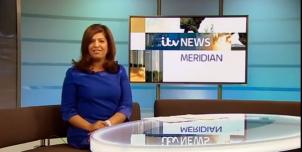Full Freeview on the Oxford (Oxfordshire, England) transmitter
| Google Streetview | Google map | Bing map | Google Earth | 51.790,-1.179 or 51°47'25"N 1°10'46"W | OX3 9SS |
The symbol shows the location of the Oxford (Oxfordshire, England) transmitter which serves 410,000 homes. The bright green areas shown where the signal from this transmitter is strong, dark green areas are poorer signals. Those parts shown in yellow may have interference on the same frequency from other masts.
This transmitter has no current reported problems
The BBC and Digital UK report there are no faults or engineering work on the Oxford (Oxfordshire, England) transmitter._______
Digital television services are broadcast on a multiplexes (or Mux) where many stations occupy a single broadcast frequency, as shown below.
64QAM 8K 3/4 27.1Mb/s DVB-T MPEG2
DTG-12 QSPK 8K 3/4 8.0Mb/s DVB-T MPEG2
H/V: aerial position (horizontal or vertical)
Which Freeview channels does the Oxford transmitter broadcast?
If you have any kind of Freeview fault, follow this Freeview reset procedure first.Digital television services are broadcast on a multiplexes (or Mux) where many stations occupy a single broadcast frequency, as shown below.
64QAM 8K 3/4 27.1Mb/s DVB-T MPEG2
DTG-12 QSPK 8K 3/4 8.0Mb/s DVB-T MPEG2
H/V: aerial position (horizontal or vertical)
Which BBC and ITV regional news can I watch from the Oxford transmitter?

BBC South (Oxford) Today 0.4m homes 1.6%
from Oxford OX2 7DW, 6km west-southwest (258°)
to BBC South (Oxford) region - 6 masts.
BBC South (Oxford) Today shares 50% content with Southampton service

ITV Meridian News 0.9m homes 3.4%
from Whiteley PO15 7AD, 102km south (182°)
to ITV Meridian/Central (Thames Valley) region - 15 masts.
Thames Valley opt-out from Meridian (South). All of lunch, weekend and 50% evening news is shared with all of Meridian+Oxford
How will the Oxford (Oxfordshire, England) transmission frequencies change over time?
| 1950s-80s | 1984-97 | 1997-98 | 1998-2011 | 2011-13 | 2013-18 | 2013-17 | 23 May 2018 | ||
| VHF | C/D E | C/D E | C/D E | C/D E | C/D E T | W T | W T | ||
| C2 | BBCtvwaves | ||||||||
| C29 | SDN | ||||||||
| C31 | com7 | com7 | |||||||
| C37 | com8 | com8 | |||||||
| C41 | BBCA | ||||||||
| C44 | D3+4 | ||||||||
| C46 | _local | ||||||||
| C47 | BBCB | ||||||||
| C49tv_off | C5waves | C5waves | |||||||
| C50tv_off | SDN | SDN | |||||||
| C51tv_off | LOX | LOX | |||||||
| C53tv_off | C4waves | C4waves | C4waves | +BBCA | +BBCA | +BBCA | |||
| C55tv_off | ArqB | ArqB | ArqB | com7tv_off | |||||
| C56tv_off | COM8tv_off | ||||||||
| C57tv_off | BBC1waves | BBC1waves | BBC1waves | BBCB | BBCB | BBCB | |||
| C59tv_off | -ArqA | -ArqA | -ArqA | ||||||
| C60tv_off | ITVwaves | ITVwaves | ITVwaves | -D3+4 | -D3+4 | -D3+4 | |||
| C62 | SDN | ||||||||
| C63 | BBC2waves | BBC2waves | BBC2waves |
tv_off Being removed from Freeview (for 5G use) after November 2020 / June 2022 - more
Table shows multiplexes names see this article;
green background for transmission frequencies
Notes: + and - denote 166kHz offset; aerial group are shown as A B C/D E K W T
waves denotes analogue; digital switchover was 14 Sep 11 and 28 Sep 11.
How do the old analogue and currrent digital signal levels compare?
| Analogue 1-4 | 500kW | |
| BBCA, D3+4, BBCB | (-7dB) 100kW | |
| SDN, ARQA, ARQB | (-10dB) 50kW | |
| Analogue 5 | (-11dB) 40kW | |
| com8 | (-14.7dB) 17.1kW | |
| com7 | (-14.8dB) 16.4kW | |
| Mux 1*, Mux 2*, LOX | (-17dB) 10kW | |
| Mux C*, Mux D* | (-18dB) 8kW | |
| Mux A*, Mux B* | (-19.2dB) 6kW |
Local transmitter maps
Oxford Freeview Oxford DAB Oxford TV region BBC South (Oxford) Meridian/Central (Thames Valley micro region)Which companies have run the Channel 3 services in the Oxford transmitter area
|
|
Monday, 17 June 2013
P
Paul7:50 AM
If the wind and rain make your TV reception worse, are there trees between the transmitter and your aerial? Wet moving leaves can cause problems.
I don't know: what was the line about digital TV providing a superior service [to analogue]? Digital has more channels than analogue and no ghosting, but digital TV's behaviour with a weak signal is more annoying that analogue TV's behaviour.
| link to this comment |
Brennig/Paul: The most common explanation for rain causing degradation to Freeview viewing is that rainwater is getting into the cables.
This can happen if the aerial has been moving around and opened up part of the construction, or - as is more common - the cable has deteriorated.
It's often best to use satellite-grade cable from the aerial to the receiver as this higher quality cable keeps out water much better.
| link to this comment |
@Paul, @Briantist
Thanks for getting back to me on my gripe.
My aerial is in the loft. There is no external installation.
There are no trees or other objects obstructing line of sight (outside the house).
This is a new (5 year old) house. When I had the aerial checked because of pixelation on the switchover to digital, the installer said I had a strong signal, and he removed the booster. Pixelation stopped, at that stage.
When the picture/sound deteriorated the other day, I had a quick (far from exhaustive) flick around the channels and deterioration was obvious on:
film4
viva
itv4
yesterday
4music
Cheers,
B.
| link to this comment |
Brennig: The terrain plot suggests that objects on the ground at High Cogges could be an issue:
Terrain between ( m a.g.l.) and (antenna m a.g.l.) - Optimising UK DTT Freeview and Radio aerial location
Also, what about the industrial estate near to you. Has a building recently gone up, or been modified in some way?
| link to this comment |
Friday, 21 June 2013
A
Algy5:14 PM
We have loss of whole groups of channels when
certain weather conditions occur.
Is it called "inversion"?
Caused by low power on the commercial channels
from Oxford and unless they increase the power it will never get better I am told!
GL544EB; 750' above sea level with new
outside aerial.
| link to this comment |
Algy: There is, since switchover, a two-tier terrestrial television transmitter network.
The coverage of the Public Service (PSB) channels (in theory) mirrors that of the former four-channel analogue network.
The Commercial (COM) channels fit in where possible and where the licensees wish to pay for transmitters. The channels/frequencies given to them are re-used in closer proximity than the PSB channels are re-used. Consequently, they are more likely to be limited in their coverage by interference. This is where the signal is present, but that there is another transmitter that is co-channel and so degrading (interfering with) the wanted signal. This is why the transmission power of the COMs is lower than the PSBs.
The Andoversford relay transmitter is co-channel with Oxford's COMs, albeit vertically polarised. Perhaps its signals are carrying further, at times, and this is what's causing your difficulty, although they are on very low power. It might be worth seeing if neighbours have the same issue.
You are, as you say, high up and appear to have quite a clear path to Oxford so the lower power COM channels may be otherwise perfectly adeqate to reach you.
The high ground at Blackheath Clump, north of Burford, is in your first Freznel zone (look it up), as the terrain plot shows:
Terrain between ( m a.g.l.) and (antenna m a.g.l.) - Optimising UK DTT Freeview and Radio aerial location
| link to this comment |
@Dave, thanks for getting back to me. No. There's been no development on any estates near me. I don't understand how high ground could affect some channels and not all channels, and even then, only in certain weather conditions, that seems odd to my technical brain.
| link to this comment |
A
Algy9:11 PM
Thanks Dave for the explanation however, I wonder if it might be Icomb Hill that is causing the problem.
Algy.
| link to this comment |
Saturday, 22 June 2013
Algy: Icomb Hill uses different channels to Oxford and therefore couldn't possibly be the issue.
| link to this comment |
Brennig: The high ground means that you may not have line-of-sight, owing perhaps to objects on the ground. Also, that high ground appears to be in your first Fresnel zone (see the terrain plot and look-up Fresnel Zone).
Different frequencies get refracted to differing degrees due to travelling through objects, hence not all channels are received at exactly the same level even though they are being radiated from the same point.
| link to this comment |
Select more comments
Your comment please





